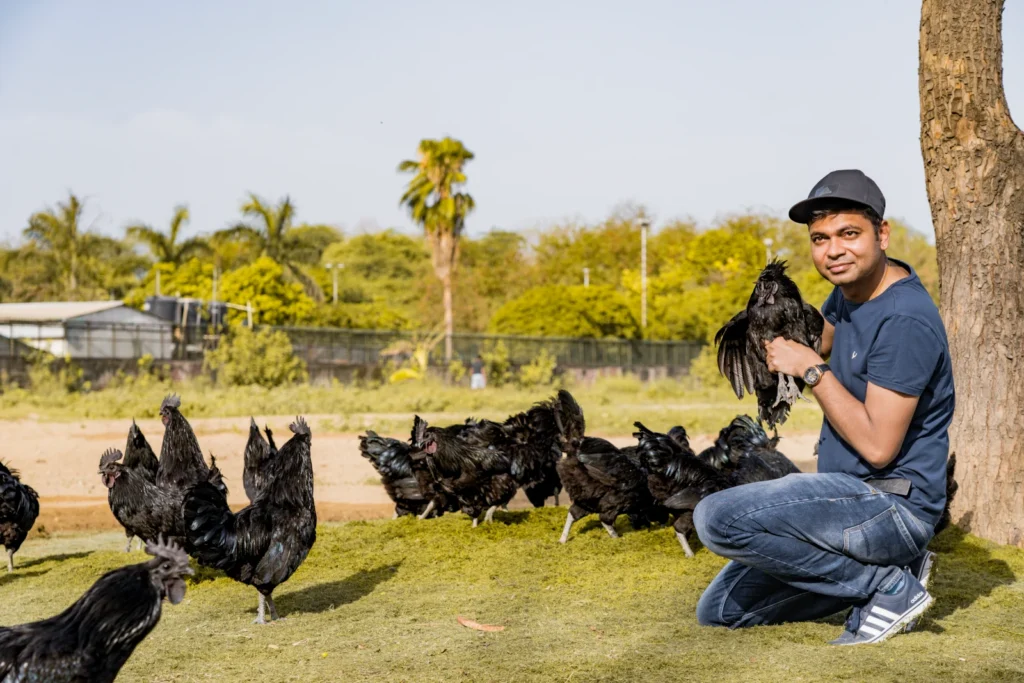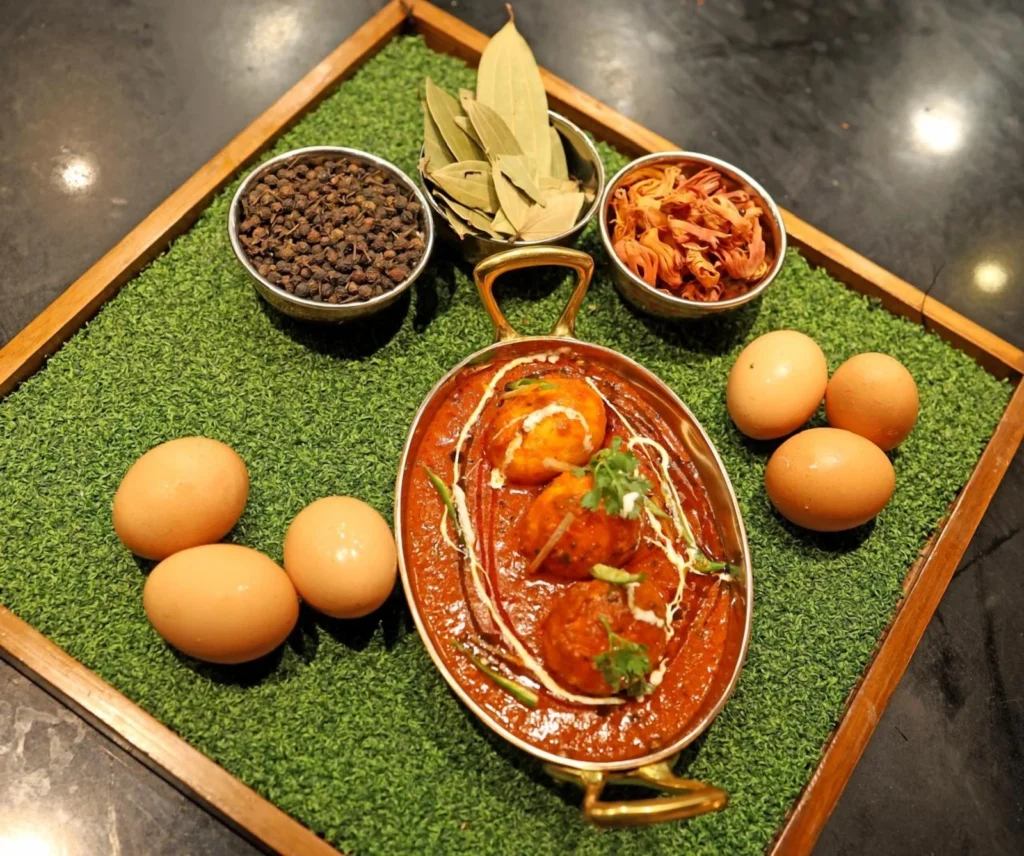Think chicken, and you are probably dreaming of a luscious, pink-hued dish. But if I told you grey meat is also chicken, you would probably beg to differ. Well, there is a unique chicken breed that is distinguished by its striking black appearance—its feathers, skin, beak, legs, bones, and even internal organs exhibit a deep black hue due to a genetic condition called fibromelanosis.

Kadaknath chicken, owing to its special black color with greenish iridescence, is one of the rarest and most expensive chickens in the world. To give a perspective, regular (broiler) chicken starts from Rs. 90 per kg to Rs. 170 per kg live. Kadaknath Chicken prices, however, start from Rs. 300 per kg and goes upto Rs. 1,200 per live.
Although more popular for its black varietal, Kadaknath chicken has other variants as well – golden and pencilled. And they lay approximately 80–100 small, brownish-pink eggs per year. The roosters weigh around 1.8–2 kg, while hens weigh 1.2–1.4 kg. Because it’s a slow grower, Kadaknath adapts beautifully to organic and free-range systems.
In 2018, Madhya Pradesh’s Kadaknath chicken received the Geographical Indication (GI) tag, recognizing its unique qualities and origin in the Jhabua district. This certification ensures that only authentic Kadaknath chicken from this region can be marketed under its name, protecting it from imitation and potentially increasing its market value.
Kadaknath chicken, owing to its special black color with greenish iridescence, is one of the rarest and most expensive chickens in the world.

But why are we talking about Kadaknath chicken? Because it seems to be raising interest among chefs and fine dining restaurants.
Health first
In a 2020 episode of Mann Ki Baat, Indian Prime Minister Narendra Modi gave a shout-out to a woman entrepreneur who started a Kadaknath chicken farm and transformed her small village economy. After that, interest in Kadaknath chicken skyrocketed, and it even made an appearance in the first edition of Celebrity MasterChef India.
It originates from the tribal communities of the Jhabua district in Madhya Pradesh. The Bhils and Bhilalas, indigenous tribes, have traditionally raised these birds for centuries. They consider Kadaknath not just food but medicine, believing it strengthens the body, boosts immunity, and even enhances masculinity. Raja Singh, founder of RB Organic Farms, New Delhi, who rears these chickens, explains, “The meat is rich in protein and essential amino acids. It contains lower fat and cholesterol levels compared to other chicken breeds. Kadaknath chicken stands out for several unique qualities that make it special and highly sought-after, especially in health-conscious and gourmet circles. It has a high nutritional value with 25%-27% more protein than any other chicken breed. Low in fat and cholesterol, it is rich in iron.”
Often referred to as black gold and the pride of Jhabua, they have essential minerals like iron, calcium, and phosphorus and vitamins. The natural antioxidants in them help combat oxidative stress and reduce the risk of chronic diseases.

Apart from this, the tribal communities in Jhabua, Madhya Pradesh believe that the meat and blood of Kadaknath chicken have medical properties and are used to treat various ailments, though scientific evidence is limited. Dheeraj Malik, executive chef at Sterling Mussoorie, says, “Often referred to as black gold and the pride of Jhabua, they have essential minerals like iron, calcium, and phosphorus and vitamins. The natural antioxidants in them help combat oxidative stress and reduce the risk of chronic diseases. As they have a low glycemic index and high protein, they are a good option for diabetics as they aid in managing blood sugar levels.”
Not to be confused with Indonesia’s Ayam Cemani – also an expensive, rare breed of black chicken – the consumption of Kadaknath chicken is associated with several health advantages. “These include anemia management, as its high iron content can help in increasing blood count and improving hemoglobin levels, particularly beneficial for individuals with anemia. It may support women’s reproductive health due to its rich nutrient profile, and the elevated protein levels are advantageous for muscle growth and repair. Low fat and cholesterol content make it a heart-healthy option for those monitoring their weight and cardiovascular health,” says Mohsin Qureshi, cluster executive chef, Saraca Hotels & Resorts.
Try it out
If we have intrigued you enough, then its perhaps time to try it out. However, the chicken dish is not easily available in all restaurants, but some do serve the same on their menu. While The Leela Palace Jaipur served a dish made from this chicken, it has since been discontinued.
But fret not. “We are going to introduce Kadaknath in our own Awadhi menu, which will be served in Awadhi-style kormas and many more styles at Azrak at Saraca Lucknow. With the onset of winter, the demand for Kadaknath chicken significantly increases. This black meat chicken is considered beneficial during the colder months. In regions like Gwalior-Chambal, poultry farms are experiencing a backlog of over 10,000 orders due to the heightened demand,” mentions Chef Qureshi.

It is one of those ingredients that’s as much about the story as it is about the taste. If you are looking to try Kadaknath chicken now, Tamra at Shangri-La Eros New Delhi is the perfect spot. Gagandeep Singh Sawhney, Executive Chef, Shangri-La Eros New Delhi, says, “We have crafted some incredible dishes like the Kadaknath Chicken Shorba, which is a flavorful, comforting broth, and the Kadaknath Egg Curry, a rich and delicious take on a classic. These dishes really highlight the unique taste and nutritional goodness of Kadaknath, and they have become quite a hit with our guests.”
Not highly available internationally due to its limited availability, Kadaknath chicken seems to be an India exclusive meat at the moment. It’s also trickier to cook, thanks to its high protein content.
Kadaknath isn’t just about the chicken—the eggs are equally impressive, prized for their high nutritional value and rich taste. So, the next time you are in India, leave some space in your appetite to try this dish.





